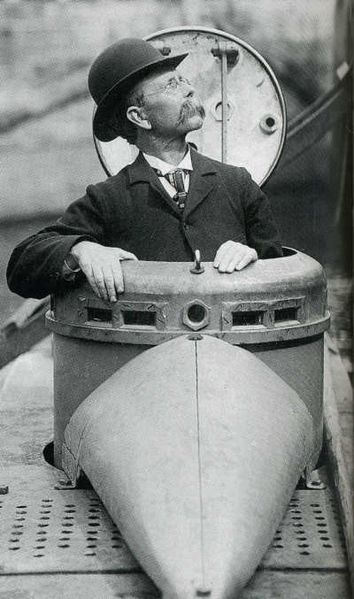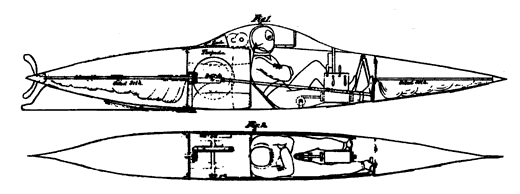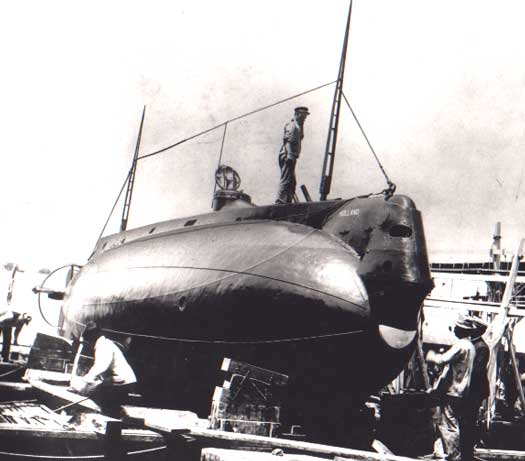Happy Birthday John Philip Holland, “Father of the Modern Submarine”
John Philip Holland, U.S. American engineer (1841-1914). Public Domain Image
One of history’s more notable leaplings, or Leap Year babies, was John Philip Holland. Called the “Father of the Modern Submarine,” Holland was born in Ireland in 1841. A teacher by profession, Holland had already developed a deep interest in submarine technology by the time he moved to the United States in 1873.
In 1874, he submitted a design to the Secretary of the Navy which was promptly passed down the chain of command. The responding officer found it difficult to fathom anyone volunteering for underwater duty and warned that “to put anything through Washington was uphill work.” Nonetheless, Holland continued his efforts and found support from the Fenian Brotherhood. His first prototype, the 15.5 foot-long Holland No. 1, was successful enough to encourage further development.
In 1881, Holland tested the Fenian Ram, but more testing was required. The relationship with the Fenians, however, dissolved in 1881 when they stole the prototype, frustrated with the amount of time the process was taking. The boat can now be seen on permanent display in Patterson, New Jersey.
In the meantime, other inventors were also working to develop submarine technology. Subsequent Holland attempts included the Zalinski Boat in 1883 (a design intended for French use), two successful U.S. Navy bids in 1887 and 1888 (both withdrawn before construction for various reasons), and another Navy bid that was stalled in 1893. Holland finally achieved success, but at some cost, with a yet another Navy contract in 1893. This new design was called the Plunger. Holland found himself compromising his design for Navy specifications, specifically the use of a steam engine over a gasoline-powered one. The result was unbearable heat for the boat’s crew. Its 1897 launch was considered a failure.
Holland, keenly aware of design issues with the Plunger, had already begun plans for a new submarine prior to the 1897 launch. An item in the New York Times on May 17, 1897, referred to the launch of the Holland IV and expressed no conclusion on the usefulness of the technology, “… the Holland, the little cigar shaped vessel owned by the inventor, which may or may not play an important part in the navies of the world in years to come, was launched from Nixon’s shipyard this morning.”
The Spanish-American War sidelined US interest in submarine technology prompting Holland to volunteer to pilot the Holland IV to Cuba and sink the Spanish fleet himself. The Navy was not amused, although then Assistant Secretary of the Navy, Theodore Roosevelt, unsuccessfully advocated purchasing the boat. Meanwhile, the oft-referenced Jules Verne Jules sent a cable to Holland competitor, Simon Lake, saying, “The conspicuous success of submarine navigation in the United States will push on under-water navigation all over the world . . . . The next war may be largely a contest between submarine boats.”
Holland finally got his opportunity to test the Holland IV with the US Navy in November of 1898. Due to a lack of funds, the designer joined forces with the Electric Boat Company (an ill-fated partnership).The Navy purchased the Holland VI (now the USS Holland) in 1900 for $150,000 (a loss of more than $86,000 to the company) and ordered another boat. After Congressional hearings and an endorsement from Admiral George Dewey, six more were ordered. After a great deal of debate, culminating with Rear Admiral A. K. Wilson calling the covert technology “underhand, unfair, and damned UnEnglish,” the British Navy also ordered five Holland boats in 1900.
Meanwhile, submarine technology was being explored to varying degrees by Span, Germany and France (which was going through a “submarine-mania” of sorts). The British were also changing their attitudes when in 1904, the British Holland subs successfully “torpedoed” four warships in defense of Portsmouth. Sadly one of the subs was sunk when it was accidentally overrun by a passenger vessel. The six-man crew was lost.
It was about this time that Holland’s relationship with Electric Boat Company officially soured and he found himself in court on numerous charges from his former partners. Although all suits were eventually dismissed, Holland was never able to make a successful run with his own company. Not to mention, many of his patents were now owned by Electric Boat Company.
By this time, submarine technology had exploded with a number of former Holland competitors getting contracts with the US Navy and well as Japan,Russia and Germany. Notably, President Theodore Roosevelt took a ride on a later Holland design in 1905 and then Ensign Chester Nimitz took command of that same boat, his first sub, in 1909.
John Philip Holland died on August 12, 1914 in Newark, New Jersey. Less than a month later, the first submarine victory of WWI cemented the role of the technology he worked his entire life to develop.
Read the New York Times obituary for John Philip Holland.
Read more about the history of submarine development at www.submarine-history.com.
- Posted :
- Post Category :
- Tags :
- Follow responses to this entry through the RSS 2.0 feed. You can skip to the end and leave a response. Pinging is currently not allowed.







Leave a Reply